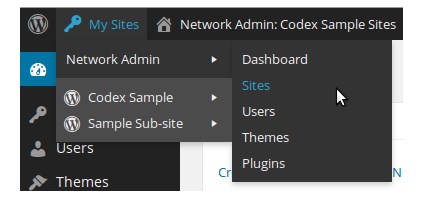We often talk to our clients about how powerful WordPress is, and that it has grown leaps and bounds from its humble beginnings as a blogger-centric platform. One great example of the robust nature of WordPress is the ability to create a network of sites all driven with a single WordPress installation by using the built in WordPress Multisite feature. When an organization has multiple websites that all need to share common features (users, theme/layout, plugins/functionality, custom database queries, etc.) then a WordPress Multisite network becomes an excellent solution.
 The most obvious advantage to using a network is that you are able to manage multiple sites from one user account. When a network is established, the WordPress admin features an additional menu item called ‘sites’ which allows you to switch from one dashboard to another for any of the websites that you have added to the network. For organizations that manage multiple websites, this is a clear advantage to having each site on a separate installation with a completely different set of users and passwords. You may ask, “what if we want some users to have access to only one of the sites that we manage?” This is a common scenario, and thankfully the multisite feature is configured out of the box to accommodate this. All users for the network are managed from a single network admin dashboard which only ‘super administrators’ can access. Users can be given access to any or all of the sites in the network with any of the standard WordPress user roles, including administrator. Only those sites which the user has access to will show up as an option in their site’s menu.
The most obvious advantage to using a network is that you are able to manage multiple sites from one user account. When a network is established, the WordPress admin features an additional menu item called ‘sites’ which allows you to switch from one dashboard to another for any of the websites that you have added to the network. For organizations that manage multiple websites, this is a clear advantage to having each site on a separate installation with a completely different set of users and passwords. You may ask, “what if we want some users to have access to only one of the sites that we manage?” This is a common scenario, and thankfully the multisite feature is configured out of the box to accommodate this. All users for the network are managed from a single network admin dashboard which only ‘super administrators’ can access. Users can be given access to any or all of the sites in the network with any of the standard WordPress user roles, including administrator. Only those sites which the user has access to will show up as an option in their site’s menu.
Another great advantage to a WordPress network is that each site shares the same common core WordPress files, allowing for additional space on the server vs. having each individual site have its own complete installation and set of core files. Likewise for the database – each site has its own set of tables within the same database, making custom database driven applications used for multiple sites on the same network much more efficient.
Plugins are also shared between sites, again minimizing the footprint of the network and allowing easy to manage shared functionality between sites. When installing a plugin, you can make it active for all sites, or just the specific sites it is needed for. Plugin settings can be customized for each individual site through their own admin as usual.
Sharing is the theme when it comes to a WordPress Multisite network, and just like core WordPress files and plugins, themes can also be shared among sites. This can be especially useful in the case of organizations that have many locations across the country and need to target local searches for their SEO strategy. Rather than spreading yourself too thin with one main web address that has subpages for each location, you can have a completely different address for each specific location. Each individual site can have its own targeted meta data, schematic markup, and microformatting (all the stuff that Google loves), but display the site using the same theme to easily maintain consistency and branding, and just feature different content specific to that location. Of course if you want each site to have a completely different theme, that is just as easy to implement. Multisite can be configured to have subdomains such as portland.yourbiz.com, subdirectories such as yourbiz.com/portland, or even completely different main urls such as yourbizportland.com, depending on your preference and marketing and SEO strategy.
Updating is another feature of multisite that has a clear advantage over keeping each site separate. Updating both the WordPress core and plugins is done through the central network administrator dashboard, making the process significantly more efficient than running the updates on each site individually, especially in the case of networks with many sites where bulk maintenance can save hours of time each month.
With all the above advantages, you may assume a network is always the way to go when managing more than one WordPress site. A word of caution here: once you establish sites on a network, pulling them apart to separate installations can be a time consuming and tricky process. If you are an organization that manages multiple sites, but you don’t see much overlap, having a network can tie the individual sites together in a way that can be difficult to manage down the road if the needs of one or more of the sites dictate it breaking off from the network. Also, compatibility issues between plugins can magnify if you have lots of sites all with completely different sets of plugins. That being said, if you are an organization that will manage multiple sites that need to share users, functionality, and themes, setting up a WordPress network using the multisite feature is a clear winner.
